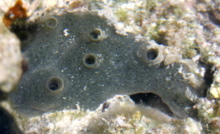| Amphimedon queenslandica | |
|---|---|

| |
| Scientific classification | |
| Domain: | Eukaryota |
| Kingdom: | Animalia |
| Phylum: | Porifera |
| Class: | Demospongiae |
| Order: | Haplosclerida |
| Family: | Niphatidae |
| Genus: | Amphimedon |
| Species: | A. queenslandica |
| Binomial name | |
| Amphimedon queenslandica Hooper & Van Soest, 2006 | |

Amphimedon queenslandica (formerly known as Reniera sp.) is a sponge native to the Great Barrier Reef. Its genome has been sequenced. It has been the subject of various studies on the evolution of metazoan development.
A. queenslandica was first discovered in 1998 on Heron Island Reef by Sally Leys when looking for sponges with larvae to study polarity, and was formally described by John Hooper and Rob van Soest in 2006. Like most sponges it has a biphasic life cycle, passing through a planktonic phase whilst a larva, but later becoming a benthic dweller. It is hermaphroditic, and reproduces via spermcast spawning, meaning it releases sperm into water but retains eggs, which are fertilised internally. The embryos develop in brood chambers until they reach a certain size, then disperse as parenchymella larvae. During this larval stage, they have a strong preference for darkness. The sponge is difficult or impossible to maintain in captivity.
Genetics
The genome of Amphimedon queenslandica was sequenced in 2009 to provide insights into the evolution of animal complexity and was the first sponge to be sequenced. Subsequent research has also sequenced the genome of the freshwater sponge Ephydatia muelleri.
References
- ^ Hooper, John N.A.; Rob W.M. Van Soest (2006-09-14). "A new species of Amphimedon (Porifera, Demospongiae, Haplosclerida, Niphatidae) from the Capricorn-Bunker Group of Islands, Great Barrier Reef, Australia: target species for the 'sponge genome project'" (PDF). Zootaxa. 1314. Magnolia Press: 31–39. doi:10.11646/zootaxa.1314.1.2. hdl:11245/1.265031. Retrieved 2010-04-07.
- ^ Adamska, M.; Degnan, S.; Green, K.; Adamski, M.; Craigie, A.; Larroux, C.; Degnan, B.; Fraser, J. (2007). Fraser, James (ed.). "Wnt and TGF-beta expression in the sponge Amphimedon queenslandica and the origin of metazoan embryonic patterning". PLOS ONE. 2 (10): e1031. Bibcode:2007PLoSO...2.1031A. doi:10.1371/journal.pone.0001031. PMC 2000352. PMID 17925879.
- ^ Sally P. Leys; Bernard M. Degnan (1 December 2001). "Cytological basis of photoresponsive behavior in a sponge larva". The Biological Bulletin. 201 (3): 323–338. doi:10.2307/1543611. ISSN 0006-3185. JSTOR 1543611. PMID 11751245. Wikidata Q56188960.
- ^ Srivastava, M.; Simakov, O.; Chapman, J.; Fahey, B.; Gauthier, M. E. A.; Mitros, T.; Richards, G. S.; Conaco, C.; Dacre, M.; Hellsten, U.; Larroux, C.; Putnam, N. H.; Stanke, M.; Adamska, M.; Darling, A.; Degnan, S. M.; Oakley, T. H.; Plachetzki, D. C.; Zhai, Y.; Adamski, M.; Calcino, A.; Cummins, S. F.; Goodstein, D. M.; Harris, C.; Jackson, D. J.; Leys, S. P.; Shu, S.; Woodcroft, B. J.; Vervoort, M.; Kosik, K. S. (2010). "The Amphimedon queenslandica genome and the evolution of animal complexity". Nature. 466 (7307): 720–726. Bibcode:2010Natur.466..720S. doi:10.1038/nature09201. PMC 3130542. PMID 20686567.
- Tompkins-Macdonald, G. .; Gallin, W. .; Sakarya, O. .; Degnan, B. .; Leys, S. .; Boland, L. . (2009). "Expression of a poriferan potassium channel: insights into the evolution of ion channels in metazoans". The Journal of Experimental Biology. 212 (Pt 6): 761–767. doi:10.1242/jeb.026971. PMC 6518305. PMID 19251990.
- ^ Degnan, B. M.; Adamska, M.; Craigie, A.; Degnan, S. M.; Fahey, B.; Gauthier, M.; Hooper, J. N. A.; Larroux, C.; Leys, S. P.; Lovas, E.; Richards, G. S. (2008). "The Demosponge Amphimedon queenslandica: Reconstructing the Ancestral Metazoan Genome and Deciphering the Origin of Animal Multicellularity". Cold Spring Harbor Protocols. 2008 (13): pdb.emo108. doi:10.1101/pdb.emo108. PMID 21356734.
- Bishop, J. D. D.; Pemberton, A. J. (2006). "The third way: spermcast mating in sessile marine invertebrates". Integrative and Comparative Biology. 46 (4): 398–406. doi:10.1093/icb/icj037. PMID 21672752.
- Leys, Sally P.; Degnan, Bernard M. (2005-05-12). "Embryogenesis and metamorphosis in a haplosclerid demosponge: gastrulation and transdifferentiation of larval ciliated cells to choanocytes". Invertebrate Biology. 121 (3): 171–189. doi:10.1111/j.1744-7410.2002.tb00058.x.
- Sally P Leys; Thomas W Cronin; Bernard M Degnan; Justin N Marshall (15 March 2002). "Spectral sensitivity in a sponge larva" (PDF). Journal of Comparative Physiology. 188 (3): 199–202. doi:10.1007/S00359-002-0293-Y. ISSN 0302-9824. PMID 11976887. Wikidata Q50500452.
- Kenny, Nathan J (27 July 2020). "Tracing animal genomic evolution with the chromosomal-level assembly of the freshwater sponge Ephydatia muelleri". Nature Communications. 11 (3676): 3676. doi:10.1038/s41467-020-17397-w. PMC 7385117. PMID 32719321.
| Taxon identifiers | |
|---|---|
| Amphimedon queenslandica | |
This article about a demosponge is a stub. You can help Misplaced Pages by expanding it. |